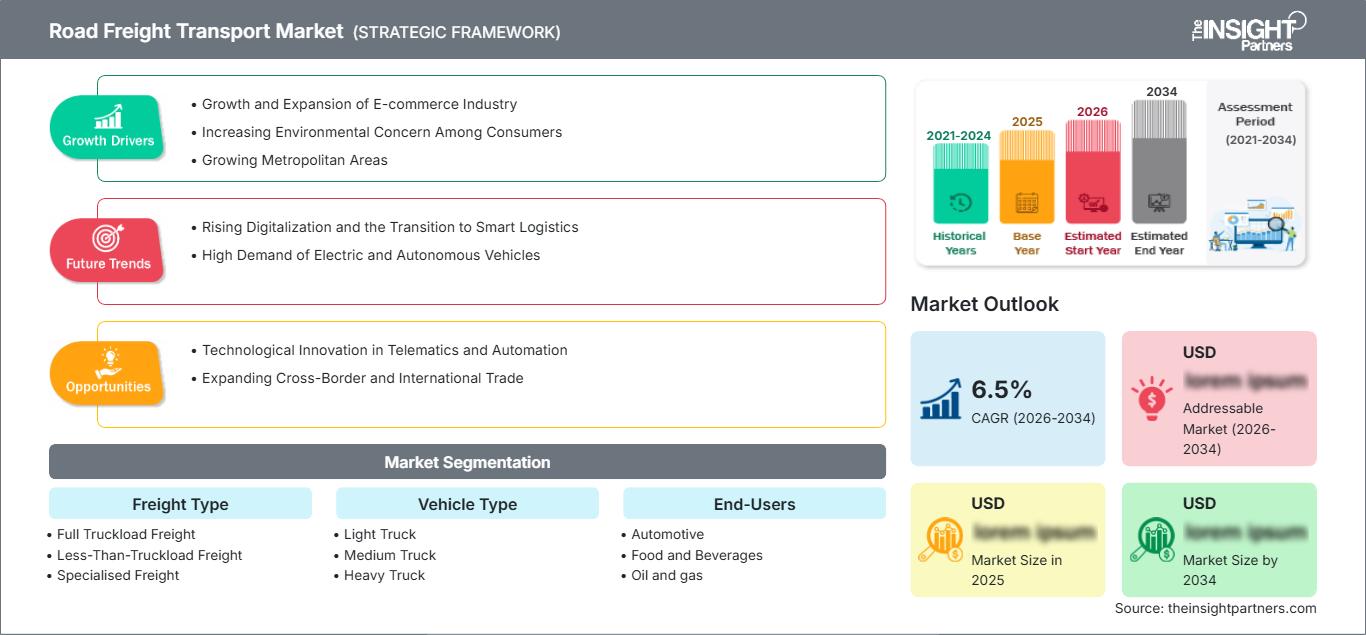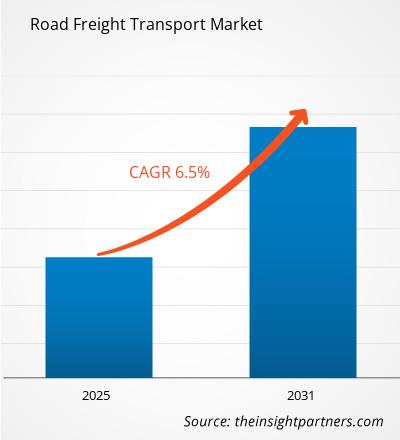Se prevé que el mercado de transporte de mercancías por carretera crezca a una tasa compuesta anual del 6,5% entre 2026 y 2034. Las condiciones del mercado siguen evolucionando, lo que abre nuevas oportunidades para los interesados. El panorama general refleja un progreso estable y un potencial de crecimiento a largo plazo.
El mercado de transporte de mercancías por carretera abarca el análisis por tipo de carga (carga completa (FTL), carga menor que carga (LTL) y carga especializada) por tipo de vehículo (camión ligero, camión medio, camión pesado); Usuarios finales (Automoción, Alimentos y Bebidas, Petróleo y gas, Químicos, Sanidad, Otros) Fuente: https://www.theinsightpartners.com/reports/road-freight-transport-market
Propósito del Informe
El informe Mercado de Transporte de Mercancías por Carretera de The Insight Partners pretende describir el panorama actual y el crecimiento futuro, los principales factores impulsores, los desafíos y las oportunidades. Esto proporcionará información a diversos actores empresariales, como:
- Proveedores de tecnología/fabricantes: Para comprender la dinámica cambiante del mercado y conocer las posibles oportunidades de crecimiento, permitiéndoles tomar decisiones estratégicas informadas.
- Inversores: Realizar un análisis exhaustivo de tendencias sobre la tasa de crecimiento del mercado, las proyecciones financieras y las oportunidades que existen a lo largo de la cadena de valor.
- Organismos reguladores: Regular las políticas y vigilar las actividades en el mercado con el objetivo de minimizar el abuso, preservar la confianza y la confianza de los inversores, y mantener la integridad y estabilidad del mercado.
Segmentación del mercado de transporte de mercancías por carretera Tipo de carga
- completa Carga
- completa Carga de carga menor decarga
- Carga especializada
Tipo de vehículo
- de carga Camión
- ligero Camión medio
- Camiones pesados
Usuarios
- finales Automoción
- Alimentos y bebidas
- Petróleo y gas
- Químicos
- Sanidad
- Otros
Geografía
- Norteamérica
- Europa
- Asia-Pacífico
- , América del Sur y Central
- , Oriente Medio y África
Disfrutará de la personalización gratuita de cualquier informe, incluyendo partes del mismo, análisis por país y un paquete de datos de Excel. Además, podrá aprovechar excelentes ofertas y descuentos para startups y universidades.
Mercado del transporte de mercancías por carretera: Perspectivas estratégicas

-
Obtenga las principales tendencias clave del mercado de este informe.Esta muestra GRATUITA incluye análisis de datos, desde tendencias del mercado hasta estimaciones y pronósticos.
Impulsores del Crecimiento del Mercado del Transporte de Mercancías por Carretera
- Crecimiento y Expansión de la Industria del Comercio Electrónico: El comercio electrónico ha surgido principalmente como una fuente del aumento de la demanda en el transporte de mercancías por carretera. Las compras en línea se vuelven cada vez más populares entre muchos clientes, por lo que las empresas de logística necesitan mejorar su capacidad de entrega, asegurándose de que se cumplan las expectativas de los clientes de un servicio puntual y confiable. Esto, por lo tanto, seguirá impulsando el crecimiento del sector en el futuro.
- Creciente Preocupación Ambiental entre los Consumidores: La creciente demanda de reducir las emisiones y alcanzar los objetivos de sostenibilidad es un factor clave en el sector del transporte de mercancías por carretera. Los gobiernos de todo el mundo están imponiendo restricciones más estrictas contra la contaminación, animando a las empresas a utilizar vehículos eléctricos o de bajo consumo de combustible. Estas restricciones están impulsando la innovación en la tecnología vehicular, como camiones eléctricos, combustibles alternativos (como el GNL) y procedimientos mejorados de gestión de flotas, para cumplir con los criterios ambientales.
- Áreas Metropolitanas en Crecimiento: La urbanización continúa en aumento, lo que requiere redes de transporte más eficientes para sostener la expansión de las regiones metropolitanas. El transporte de mercancías por carretera es fundamental para las cadenas de suministro, especialmente en zonas metropolitanas y periurbanas donde los artículos deben transportarse con rapidez. Las inversiones gubernamentales en infraestructura vial, como autopistas, puentes y terminales de carga, mejoran la capacidad de la industria para gestionar un mayor tráfico y el transporte de mercancías.
Tendencias futuras del mercado del transporte de mercancías por carretera
- Aumento de la digitalización y la transición a la logística inteligente: El sector del transporte de mercancías por carretera está adoptando rápidamente la tecnología digital para mejorar la eficiencia y la visibilidad. Las tecnologías de logística inteligente, las plataformas basadas en la nube y el seguimiento en tiempo real están cambiando la forma en que se rastrean y controlan los artículos durante el transporte. Estas soluciones digitales permiten a los transportistas y a las empresas de transporte optimizar las rutas de entrega, supervisar las condiciones de la carga (por ejemplo, cargas sensibles a la temperatura) y mejorar el servicio al cliente mediante notificaciones en tiempo real.
- Alta demanda de vehículos eléctricos y autónomos: El auge de los vehículos eléctricos (VE) y los camiones autónomos es una de las tendencias más transformadoras en la industria del transporte de mercancías por carretera. Se está investigando el uso de VE como una posibilidad para reducir el impacto de carbono del transporte de mercancías. A medida que la tecnología de baterías avanza y la infraestructura de carga se expande, el uso de camiones eléctricos crecerá, especialmente para entregas urbanas. Los camiones autónomos, aunque aún se encuentran en sus etapas iniciales, tienen el potencial de transformar el transporte de mercancías de larga distancia al reducir los costos laborales y aumentar la seguridad con sensores avanzados y tecnologías basadas en IA.
Oportunidades del mercado del transporte de mercancías por carretera
- Innovación tecnológica en telemática y automatización: La integración de la tecnología en el transporte de mercancías por carretera crea perspectivas sustanciales. Las soluciones telemáticas permiten a las empresas monitorear el rendimiento de la flota, optimizar las rutas y aumentar la eficiencia del combustible. Además, la automatización, como los automóviles autónomos o los drones para entregas de corta distancia, ofrece perspectivas futuras para ahorrar costos, aumentar la seguridad y acortar los plazos de entrega. Las empresas pueden utilizar estas tecnologías para optimizar el uso de los activos y mantenerse competitivas.
- Expansión del comercio transfronterizo e internacional: La globalización y la creciente complejidad de las cadenas de suministro han creado perspectivas para el transporte de mercancías por carretera transfronterizo e internacional. Los países están fortaleciendo los acuerdos comerciales transfronterizos, agilizando los trámites aduaneros y reduciendo las barreras comerciales, lo que facilita a los operadores de transporte de mercancías por carretera el traslado de mercancías entre zonas. La combinación de redes viales, ferroviarias y marítimas (transporte intermodal) mejora la eficiencia del comercio global y crea nuevos mercados.
Mercado del transporte de mercancías por carretera
Los analistas de The Insight Partners han explicado detalladamente las tendencias regionales y los factores que influyen en el mercado del transporte de mercancías por carretera durante el período de pronóstico. Esta sección también analiza los segmentos y la geografía del mercado de gestión de enfermedades del ritmo cardíaco en América del Norte, Europa, Asia Pacífico, Oriente Medio y África, y América del Sur y Central.
Alcance del informe del mercado de transporte de mercancías por carretera
By Tipo de vehículo- camión ligero
- camión mediano
- camión pesado
- automoción
- alimentos y bebidas
- petróleo y gas
- productos químicos
- atención sanitaria
- otros
- América del Norte
- Europa
- Asia-Pacífico
- América del Sur y Central
- Oriente Medio y África
- Reino Unido
- Alemania
- Francia
- Rusia
- Italia
- Resto de Europa
- China
- India
- Japón
- Australia
- Resto de Asia-Pacífico
- Brasil
- Argentina
- Resto de América del Sur y Central
- Sudáfrica
- Arabia Saudita
- Emiratos Árabes Unidos
- Resto de Oriente Medio y África
Atributo del informe Detalles Tamaño del mercado en 2025 US$ XX Million Tamaño del mercado por 2034 US$ XX Million CAGR global (2026 - 2034) 6.5% Datos históricos 2021-2024 Período de pronóstico 2026-2034 Segmentos cubiertos By Tipo de carga - carga completa
- carga fraccionada
- carga especializada
Regiones y países cubiertos Norteamérica - EE. UU.
- Canadá
- México
Líderes del mercado y perfiles de empresas clave - Bolloré Logistics Germany0 GmbH
- DHL International GmbH
- DSV
- GEFCO
- Kerry Logistics Network Limited
- Kuehne+Nagel
- Nippon Express (Europe) GmbH
- PRIMAFRIO SL
- United Parcel Service
Densidad de actores del mercado del transporte de mercancías por carretera: comprensión de su impacto en la dinámica empresarial
El mercado del transporte de mercancías por carretera está creciendo rápidamente, impulsado por la creciente demanda del usuario final debido a factores como la evolución de las preferencias de los consumidores, los avances tecnológicos y un mayor conocimiento de los beneficios del producto. A medida que aumenta la demanda, las empresas amplían su oferta, innovan para satisfacer las necesidades de los consumidores y aprovechan las tendencias emergentes, lo que impulsa aún más el crecimiento del mercado.

- Conseguir el Mercado del transporte de mercancías por carretera Resumen de las principales jugadoras clave
Puntos Clave de Venta
- Cobertura Integral: El informe abarca el análisis exhaustivo de productos, servicios, tipos y usuarios finales del Mercado de Transporte de Mercancías por Carretera, ofreciendo un panorama holístico.
- Análisis de Expertos: El informe se elabora con base en el profundo conocimiento de expertos y analistas del sector.
- Información Actualizada: El informe garantiza relevancia para el negocio gracias a su cobertura de información y tendencias de datos recientes.
- Opciones de Personalización: Este informe se puede personalizar para satisfacer las necesidades específicas del cliente y adaptarse a las estrategias comerciales.
Por lo tanto, el informe de investigación sobre el Mercado de Transporte de Mercancías por Carretera puede ayudar a descifrar y comprender el panorama del sector y las perspectivas de crecimiento. Si bien existen algunas preocupaciones válidas, las ventajas generales de este informe tienden a superar las desventajas.
- Análisis histórico (2 años), año base, pronóstico (7 años) con CAGR
- Análisis PEST y FODA
- Tamaño del mercado, valor/volumen: global, regional y nacional
- Industria y panorama competitivo
- Conjunto de datos de Excel
Informes recientes
Informes relacionados
Testimonios
Razón para comprar
- Toma de decisiones informada
- Comprensión de la dinámica del mercado
- Análisis competitivo
- Información sobre clientes
- Pronósticos del mercado
- Mitigación de riesgos
- Planificación estratégica
- Justificación de la inversión
- Identificación de mercados emergentes
- Mejora de las estrategias de marketing
- Impulso de la eficiencia operativa
- Alineación con las tendencias regulatorias






















 Obtenga una muestra gratuita para - Mercado del transporte de mercancías por carretera
Obtenga una muestra gratuita para - Mercado del transporte de mercancías por carretera